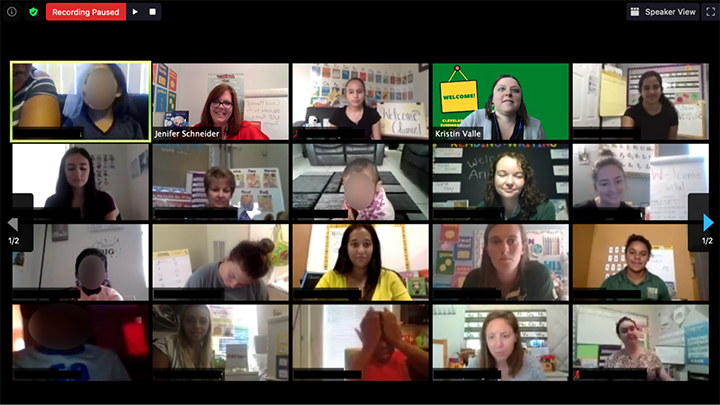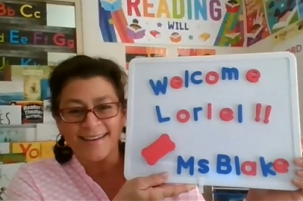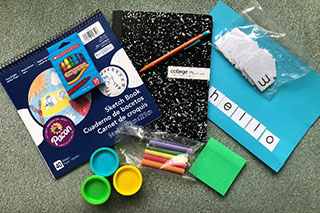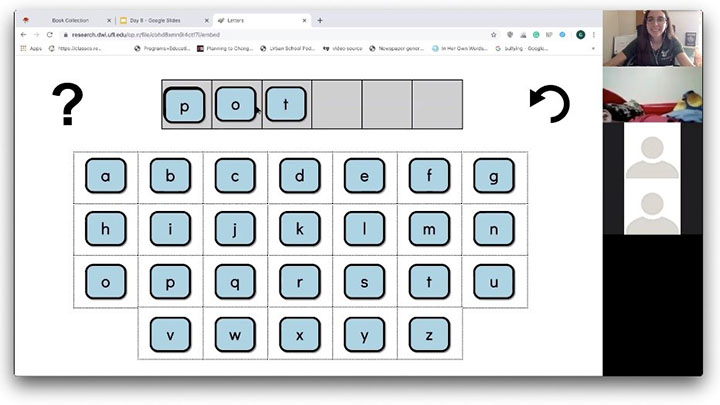2020 News Stories
USF students gain literacy teaching skills through virtual tutoring program

In response to USF's shift to fully-online instruction due to the coronavirus pandemic, the College of Education's summer literacy practicum course was hosted in a format that gave USF students experience tutoring preschool and elementary-aged students in virtual settings.
by Jessenia Rivera
When Elementary Education major Consuelo Blake began her summer literacy practicum course, she was determined to make an impact in her student’s learning, however she could.
After learning that she would spend four weeks virtually tutoring a student, Blake began her first online session with an attempt to establish a connection with her student on the other end of the screen by welcoming her to a self-decorated classroom in her home and by holding up a sign that read “Welcome Loriel!!”
The goal for Blake, and the other 140 USF students enrolled in the summer course, was to apply what they learned through previous coursework and provide specific reading instruction to their assigned child in order to support their literacy needs.
Jenifer Jasinski Schneider, PhD, lead instructor and professor of literacy studies at USF’s College of Education, says the practicum, which transitioned to an online teaching experience due to the ongoing COVID-19 pandemic, allowed children from five partner schools―Cleveland Elementary, Watergrass Elementary, McKeel Academy, Pepin Academies and the USF Preschool for Creative Learning―to learn new literacy skills and improve upon the skills they had from the start.
“In the first week of the practicum, the preservice teachers administered literacy assessments and interest inventories to determine what each child could do,” Dr. Schneider said. “Students then had to teach right at the point of where a child could go next and also plan based on the child’s interest.”

USF student Consuelo Blake on her first day as a virtual tutor.
It took a few virtual meetings for Blake to discover that her student loves cheerleading, wants to attend USF someday and was more motivated to engage in assignments when beach-like activities took place.
As Blake listened to her student read aloud during a session, she noticed the student read through punctuation, which prompted Blake to create lessons that targeted her student's learning needs.
“We worked together on fluency, paying attention to question marks and speaking how the character would,” Blake said. “We practiced with a short book called, ‘Yo! Yes?’ and she had this ‘Aha’ moment when she understood how to read the phrasing with emphasis.”
Each online tutoring session occurred in individual meeting rooms and was one-hour long. The teachers followed a modified literacy schedule that included a morning meeting, reading aloud, guided reading with word study, an educational game and a writing activity. As USF students tutored their children, their course instructors virtually joined the chat room to observe and provide instructional feedback during and after each session.
Despite the challenges that came with the shift to fully online teaching observation, Dr. Schneider shared one positive aspect she found to be beneficial for student educators.
“Last year, we were in large spaces where we didn’t have that closeness,” Dr. Schneider said. “(This year), we were able to watch how a teacher explained letter sounds and if (he or) she was understanding when the child was learning and when the child wasn’t learning. We could tell which teachers were able to adapt and provide appropriate instruction and then jump in and support those teachers that weren’t.”

Children who participated in the four-week virtual tutoring experience received a pack of supplies that contained necessary items they would use during lessons.
Anna Pace, a senior majoring in Exceptional Student Education, shared how confronting struggles, such as making sudden adjustments to lesson plans, teaching under a time limit, and breaking through her student’s shyness barrier only served to confirm what she already knew about teaching.
Having an assigned mentor who observed her teaching practice carefully is what Pace says enabled her to overcome these obstacles and improve her self-efficacy.
“I thought it was nerve wracking at first, but it was a fantastic experience because they were able to reinforce that what I’m doing is working and that it’s good for my student,” Pace said. “It’s one thing to read it in a book―this is how you do the lesson, this is how you do the activity―but it’s completely different when you have to (teach) in the moment.”
Pace said she made it a priority to help her student learn sight words and increase his reading speed. With repeated readings and a writing project embedded into her lesson plan, Pace was able to witness a significant improvement not just in her student’s fluency development, but also in the way she began to approach given tasks.
“We were able to go through the steps of writing: picking a theme, doing research and figuring out structure, and we ended up doing an infographic,” Pace said. “Being able to create something himself with my guidance really helped build his confidence because he didn’t really believe in his abilities.”

USF student Gabriella Frongillo uses a virtual word map to create words with her student during a virtual tutoring session.
For Gabriella Frongillo, a junior in the Elementary Education program at USF, the first couple tutoring sessions with her incoming second grader led her to set two distinct goals—encouraging her student to read for pleasure and teaching him how to differentiate between vowel sounds.
While Frongillo created lessons that were centered on vowel isolation, she also began to read one book each session, all with the aim of having her student answer one specific question by the end of her practicum course.
“My goal, above anything else, was to get him to have an answer to the question, ‘What is your favorite book?’” Frongillo said. “That was one way that I saw him grow because by the end of our sessions, he was asking me, ‘Can we read a book about this? So, he definitely started to understand that reading was something you can enjoy.’’
Building a relationship with her student allowed Frongillo to make an academic and personal impact. While she initially wanted to have a face-to-face teaching experience in the classroom, Frongillo said she feels satisfied knowing that her time as a literacy tutor this summer served to better her teaching skills and abilities.
“I think the number one thing I learned from this experience is flexibility,” Frongillo said. “At the end of the day, you can have the most well-thought out lesson, but something unexpected can happen and that all needs to change. If you’re really rigid in your expectations, it’s just not going to work.”